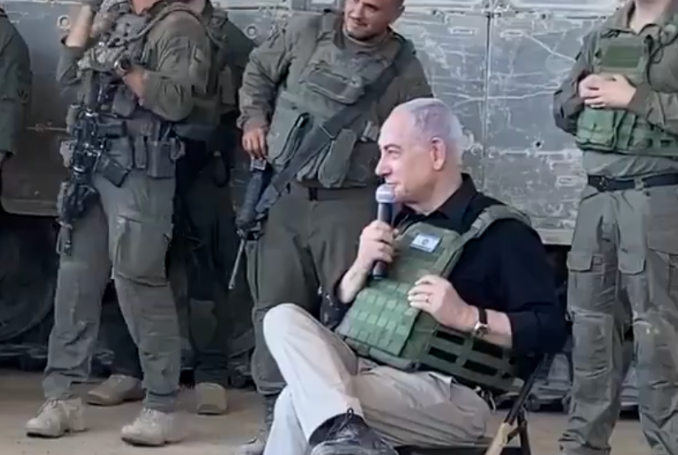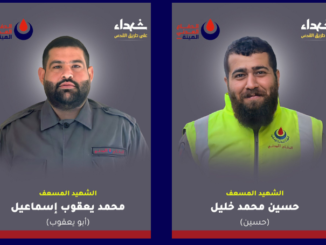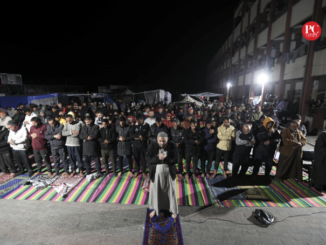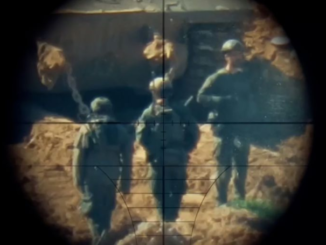
Netanyahu’s tour preceded a crucial meeting by the Israeli War Cabinet, which will reportedly include negotiation team members and security officials.
Israeli Prime Minister Benjamin Netanyahu visited Rafah and the Philadelphi Route in the southern Gaza Strip on Thursday, Israeli media reported.
The visit comes amid ongoing negotiations to reach an agreement with the Palestinian Resistance Movement Hamas for the release of Israeli captives currently held in Gaza, according to Israel’s public broadcaster KAN.
Netanyahu’s tour preceded a crucial meeting by the Israeli War Cabinet, which will reportedly include negotiation team members and security officials to discuss the potential prisoner exchange deal.
Israeli ?? Prime Minister Benjamin Netanyahu has returned from a visit to Gaza’s southernmost city of Rafah ??, his office announceshttps://t.co/IsrV0VgV8X pic.twitter.com/5MmIKPXEwI
— Saad Abedine (@SaadAbedine) July 18, 2024
During his visit, Netanyahu pledged to uphold Israeli control over the Rafah crossing and the entire Gaza-Egypt border, even if a ceasefire agreement is reached.
In a video statement surrounded by soldiers, Netanyahu said, “I got here stronger in the understanding that our control of the Philadelphia Route and the Rafah crossing is essential for the future.”
Netanyahu also announced plans to travel to Washington next week to address the US Congress, where he claimed that he will present the “righteousness” of the ongoing Israeli actions in Gaza.
Meanwhile, an Israeli delegation is in Cairo for further talks on the agreement.
What is the Philadelphi Route?
The Philadelphi Route, or Philadelphi Corridor – often referred to as Philadelphia, is a narrow strip of land, long 14 kilometers, located along the border between southern Gaza and Egypt.
In the past, the corridor was under the control of Israeli forces, which patrolled it under the provisions of the Egypt-Israel Peace Treaty of 1979.
Israel was allowed to control the corridor even after the Oslo Accords of 1993.
Only in 2005, when Israeli troops redeployed from the Gaza Strip, Egypt and Israel concluded the Philadelphi Accord.
Then, Egypt was committed to deploy 750 border guards along the route to patrol the border on the Egyptian side, while the Palestinian side remained under the control of the Palestinians.
Israel aims at completely isolating the already besieged Gaza Strip from the rest of the world.
The Rafah crossing, which is located along the border with Egypt, is the only crossing that is not directly controlled by Israel.
Gazans are not allowed to use other crossings to enter or exit the besieged Strip.
The Palestinian Resistance groups are perfectly aware of the strategic importance of the Philadelphi Route.
"What's next? The north"
From Netanyahu's visit to the occupied Rafah Crossing between Gaza and Egypt, he was recorded asking the soldiers what to do next. They responded by suggesting initiating another war in the "north," referring to Lebanon. pic.twitter.com/8mMX81Q8Jh
— Quds News Network (@QudsNen) July 18, 2024
Ongoing Genocide
Currently on trial before the International Court of Justice for genocide against Palestinians, Israel has been waging a devastating war on Gaza since October 7.
According to Gaza’s Ministry of Health, 38,848 Palestinians have been killed, and 89,459 wounded in Israel’s ongoing genocide in Gaza starting on October 7.
Moreover, at least 11,000 people are unaccounted for, presumed dead under the rubble of their homes throughout the Strip.
Israel says that 1,200 soldiers and civilians were killed during the Al-Aqsa Flood Operation on October 7. Israeli media published reports suggesting that many Israelis were killed on that day by ‘friendly fire’.
Palestinian and international organizations say that the majority of those killed and wounded are women and children.
The Israeli war has resulted in an acute famine, mostly in northern Gaza, resulting in the death of many Palestinians, mostly children.
The Israeli aggression has also resulted in the forceful displacement of nearly two million people from all over the Gaza Strip, with the vast majority of the displaced forced into the densely crowded southern city of Rafah near the border with Egypt – in what has become Palestine’s largest mass exodus since the 1948 Nakba.
Later in the war, hundreds of thousands of Palestinians began moving from the south to central Gaza in a constant search for safety.
(The Palestine Chronicle)









A tiny widdel bullet-pwoof vest?
how is that protection? As if they wouldn’t aim for his head…
he’s obviously not in a war-torn area. A very quaint publicity photo.
Already stuck in Gaza’s quagmire,and still believing in the myth of “invincible army”, the idiots want to attack Hezbollah, which is tenfold stronger than Hamas. The Zionists only understand the languages of arms and violence, and such ideology will lead them to their destruction. Hopefully, the cancer of the Middle East will be eradicated soon.